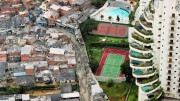Labor Rights in Brazil
Laborers in Brazil face serious human rights abuses as they are subjected to exploitation in many forms. There is debt bondage, a form of slavery in which companies outsource to immigrants and then subject them to exploitation because they are vulnerable in the unfamiliar environment and do not know their legal rights. Brazilians also face horrible working conditions, forced labor, child labor, and physical and emotional abuse. There is not enough being done at the moment to resolve numerous violations of human rights.
Sources to Consult
- http://www.solidaritycenter.org/where-we-work/americas/brazil/
- http://www.cnn.com/2009/WORLD/americas/01/09/brazil.slavery/index.html
- http://www.reuters.com/article/brazil-slavery/more-than-300-brazilian-companies-busted-for-modern-day-slavery-campaigners-idUSL8N15U3CD
- http://ebookcentral.proquest.com.ezproxy4.library.arizona.edu/lib/UAZ/detail.action?docID=529942
- http://www.hardrainproject.com/hrpl?n=6253
- http://www.tandfonline.com.ezproxy2.library.arizona.edu/doi/citedby/10.1080/13691457.2014.947245?scroll=top&needAccess=true
- http://universityofarizona.worldcat.org/title/health-education-and-childrens-rights-a-comparability-analysis-of-kenya-and-brazil/oclc/972667800&referer=brief_results
- http://search.alexanderstreet.com.ezproxy4.library.arizona.edu/view/work/bibliographic_entity%7Cbibliographic_details%7C915424#page/7/mode/1/chapter/bibliographic_entity%7Cdocument%7C915662
- http://i2.cdn.cnn.com/cnnnext/dam/assets/160525133401-paraisopolis-rugby-para-todos-exlarge-169.jpg
- http://arizona.summon.serialssolutions.com.ezproxy4.library.arizona.edu/2.0.0/link?t=1504995017936
- http://www.conectas.org/en/about-us
- http://www.un.org/en/letsfightracism/oliveira.shtml
- http://bi.galegroup.com.ezproxy1.library.arizona.edu/essentials/article/GALE%7CA457541248/0098303959c8ffb989cebc2b53e2da25?u=uarizona_main
- https://ladb.unm.edu/notisur/2016/03/18-079924
- https://www.cia.gov/library/readingroom/docs/CIA-RDP83S00855R000100160004-4.pdf
- http://journals.sagepub.com.ezproxy1.library.arizona.edu/doi/pdf/10.1177/0921374013498140
Ideas for helping out with the issue
- Supporting and donating to the labor unions
- Boycotting exploitative countries, Legal support for Migrant workers
- America could put pressure on the Brazilian government to change its labor laws and regulations
- Activism and litigation to overturn unjust judicial decisions
1) Academic Articles (From Academic Search Premier or other Library Databases) Citation: McPherson, Jane. “Human Rights Practice in Social Work: A US Social Worker Looks to Brazil for Leadership.” European Journal of Social Work, vol. 18, no. 4, 2015, pp. 599-612
2)Lopez, Charlette. Health, Education and Children’s Rights: A Comparability Analysis of Kenya and Brazil. , 2015. Internet resource.
Description: This book force on the children’s human rights in Kenya and Brazil. Both countries are facing in the challenges that to provide sufficient access to quality health care and educational resources to children. This book also explores whether corruption plays major role in contributing to the violation of children’s rights.
3)Cannon, Mary M. (Mary Minerva), and United States. Women’s Bureau. Women Workers in Brazil. U.S. Government Printing Office, Washington, DC, 1945. Description: The book discusses the social and economic issues that women face in the Brazilian workforce. This includes the shame they recieve for leaving the home, the sexual harassment, and awful working conditions they endure, as well as unequal pay.
Description: The book discusses the social and economic issues that women face in the Brazilian workforce. This includes the shame they recieve for leaving the home, the sexual harassment, and awful working conditions they endure, as well as unequal pay.
4)This photograph shows the contrast between rich and poor in Sao Paulo’s Paraisopolis (“Paradise City”). One side of the barrier is clean, but other side is the second biggest favela, with a population estimated att 100,000. “Deaths and drug deals are not uncommon in these streets, which are packed with 20,000 homes.”
5)Vazquez, Rodrigo. Brazil: Memories of a Dirty War. Java Films, 23128, 2013.
Describe: “In 2012, President Dilma Rouseff created the Truth Commission to investigate human rights abuses committed by the military regime that ruled Brazil from 1964 to 1985. Members of the security forces have been called to collaborate but only one has stepped forward: Claudio Guerra. In the 1970s, he was a key player in Brazil’s paramilitary repression. His shocking confession reveals how agents of a murderous regime tortured and killed Brazilians for almost 40 years.”
6) Scruggs, Gregory. Brazil Faces Modern Slavery Allegations at Inter-American Commission on Human Rights. Latin American Data Base/Latin American Institute, 2016. Brazil faces modern slavery allegations at Inter-American Commission on Human Rights Describe: This is a case about the modern slavery allegations in Brazil. Two human rights group accused the Brazilian government of gross negligence. “The United Nations’ International Labor Organization (ILO) estimated in 2008 that 25,000 to 40,000 workers are in conditions analogous to slavery in Brazil.”
7)“Conectas is a non-governmental and not-for-profit organization founded in São Paulo/Brazil in September 2001.” They develops its activities through three programs south-south, foreign policy and justice. Each of the program aims to strengthen human rights defenders and academics in the Global South and to foster interaction between them, through networks.
8)“Fight, racism, antiracism, racial, take a stand, discrimination, advocating, human rights, justice, United Nations, UN.” United Nations, United Nations, Summary: Creuza Oliveira a domestic worker in Brazil, discusses the exploitation and inequalities she experienced in Brazil.
9)”UN: Brazil must advance business and human rights.” Legal Monitor Worldwide 18 June 2016. Business Insights: Essentials. Web. 9 Sept. 2017. In this UN report, the Working Group focused upon several issues affected by business operations within the Brazil, including the displacement of indigenous populations, increased death threats against human rights activists where “their rights are compromised by economic interests,” and failure to effectively address both child and slave labor.
10)United States, Congress, Directorate of Intelligence. “Organized Labor in Brazil.” Organized Labor in Brazil.
11)Solidarity Center: Citation: “Brazil.” Solidarity Center, www.solidaritycenter.org/where-we-work/americas/brazil/. Accessed 10 Sept. 2017.
12)PRI – Across Women’s Lives – How a whisper can help fight labor trafficking
Citation: “Across Women’s Lives by PRI on Apple Podcasts.” Apple Podcasts, itunes.apple.com/us/podcast/how-a-whisper-can-help-fight-labor-trafficking-in-brazil/id966714800?i=1000385629978&mt=2. Accessed 10 Sept. 2017. Summary: A migrant in Brazil is forced to work in a sweatshop and discusses the rising labor trafficking in Brazil
13)Darlington, Shasta. “Thousands forced to work on Brazil’s cattle ranches.” CNN, Cable News Network, 11 May 2017, www.cnn.com/2017/04/26/americas/brazil-amazon-slavery-freedom-project/index.html. Accessed 10 Sept. 2017.
14)”List of Goods Produced by Child Labor or Forced Labor.” United States Department of Labor. Bureau of International Labor Affairs, 30 Sept. 2016. Web. 10 Sept. 2017. Annotation: This interactive source from the US Department of Labor shows what products are produced in different countries as a result of exploited labor. The report can also be viewed in PDF form by clicking on a link on the website.
15)BISCHOFF, JAMES L. “Forced Labour in Brazil: International Criminal Law as the Ultima Ratio Modality of Human Rights Protection.” Leiden Journal of International Law, vol. 19, no. 1, 2006, pp. 151-193.
16) Bice, Arthur. “Government Fights Slave Labor in Brazil.” CNN. Cable News Network, 9 Jan. 2009. Web. 10 Sept. 2017.
17)Costa, Patricía T. M., Inc ebrary, and International Labour Office. Special Action Programme to Combat Forced Labour. Fighting Forced Labour: The Example of Brazil. International Labour Office, Geneva, 2009.
18)Moloney, Anastasia. “More than 300 Brazilian Companies Busted for Modern-day Slavery – Campaigners.” Reuters. Thomson Reuters, 15 Feb. 2016. Web. 10 Sept. 2017.
19)Noronha, Eduardo G. “Informal, illegal and unfair: perceptions of labor markets in Brazil.” Revista Brasileira de Ciências Sociais 1.SE (2005): 0-0.
20)Nielsen, Goran S., and Inc ebrary. Brazil, Cuba, and Mexico: Human Rights and Religious Freedom Reports. Nova Publishers, New York, 2013. 20)

